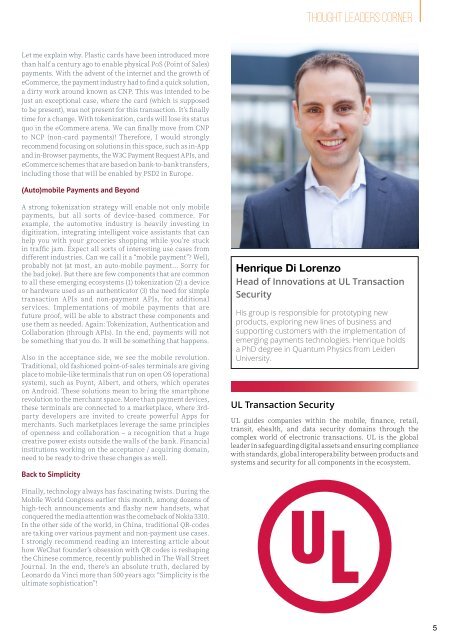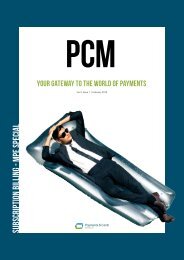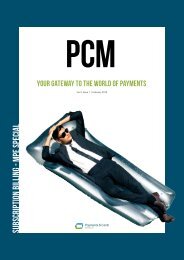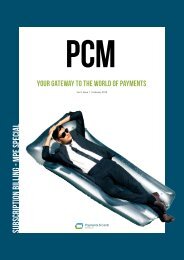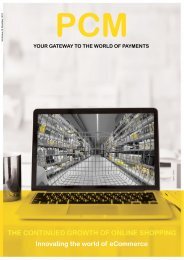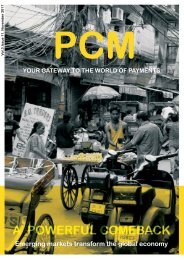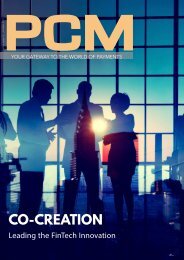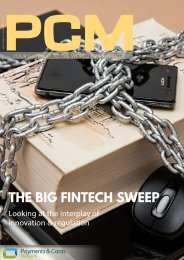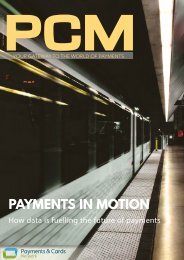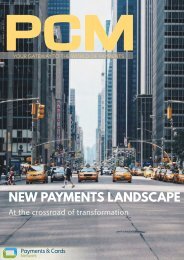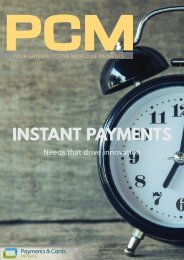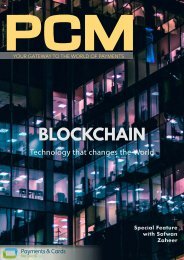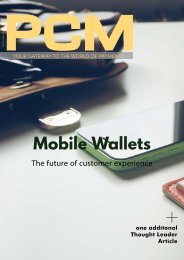PCM vol. 3 issue 3
The third issue of the Payments & Cards eMagazine \"PCM\". In this issue we talk about all things Mobile Payments and we introduce the new rubric for Merchants. Contributions from ACI WorldWide, UL, Payr, Zooz, Zapp Mobile Payments and Neste Oil.
The third issue of the Payments & Cards eMagazine \"PCM\". In this issue we talk about all things Mobile Payments and we introduce the new rubric for Merchants. Contributions from ACI WorldWide, UL, Payr, Zooz, Zapp Mobile Payments and Neste Oil.
Create successful ePaper yourself
Turn your PDF publications into a flip-book with our unique Google optimized e-Paper software.
Thought Leaders Corner<br />
Let me explain why. Plastic cards have been introduced more<br />
than half a century ago to enable physical PoS (Point of Sales)<br />
payments. With the advent of the internet and the growth of<br />
eCommerce, the payment industry had to find a quick solution,<br />
a dirty work around known as CNP. This was intended to be<br />
just an exceptional case, where the card (which is supposed<br />
to be present), was not present for this transaction. It’s finally<br />
time for a change. With tokenization, cards will lose its status<br />
quo in the eCommere arena. We can finally move from CNP<br />
to NCP (non-card payments)! Therefore, I would strongly<br />
recommend focusing on solutions in this space, such as in-App<br />
and in-Browser payments, the W3C Payment Request APIs, and<br />
eCommerce schemes that are based on bank-to-bank transfers,<br />
including those that will be enabled by PSD2 in Europe.<br />
(Auto)mobile Payments and Beyond<br />
A strong tokenization strategy will enable not only mobile<br />
payments, but all sorts of device-based commerce. For<br />
example, the automotive industry is heavily investing in<br />
digitization, integrating intelligent voice assistants that can<br />
help you with your groceries shopping while you’re stuck<br />
in traffic jam. Expect all sorts of interesting use cases from<br />
different industries. Can we call it a “mobile payment”? Well,<br />
probably not (at most, an auto-mobile payment… Sorry for<br />
the bad joke). But there are few components that are common<br />
to all these emerging ecosystems (1) tokenization (2) a device<br />
or hardware used as an authenticator (3) the need for simple<br />
transaction APIs and non-payment APIs, for additional<br />
services. Implementations of mobile payments that are<br />
future proof, will be able to abstract these components and<br />
use them as needed. Again: Tokenization, Authentication and<br />
Collaboration (through APIs). In the end, payments will not<br />
be something that you do. It will be something that happens.<br />
Also in the acceptance side, we see the mobile re<strong>vol</strong>ution.<br />
Traditional, old fashioned point-of-sales terminals are giving<br />
place to mobile-like terminals that run on open OS (operational<br />
system), such as Poynt, Albert, and others, which operates<br />
on Android. These solutions mean to bring the smartphone<br />
re<strong>vol</strong>ution to the merchant space. More than payment devices,<br />
these terminals are connected to a marketplace, where 3rdparty<br />
developers are invited to create powerful Apps for<br />
merchants. Such marketplaces leverage the same principles<br />
of openness and collaboration – a recognition that a huge<br />
creative power exists outside the walls of the bank. Financial<br />
institutions working on the acceptance / acquiring domain,<br />
need to be ready to drive these changes as well.<br />
Back to Simplicity<br />
Henrique Di Lorenzo<br />
Head of Innovations at UL Transaction<br />
Security<br />
His group is responsible for prototyping new<br />
products, exploring new lines of business and<br />
supporting customers with the implementation of<br />
emerging payments technologies. Henrique holds<br />
a PhD degree in Quantum Physics from Leiden<br />
University.<br />
UL Transaction Security<br />
UL guides companies within the mobile, finance, retail,<br />
transit, ehealth, and data security domains through the<br />
complex world of electronic transactions. UL is the global<br />
leader in safeguarding digital assets and ensuring compliance<br />
with standards, global interoperability between products and<br />
systems and security for all components in the ecosystem.<br />
Finally, technology always has fascinating twists. During the<br />
Mobile World Congress earlier this month, among dozens of<br />
high-tech announcements and flashy new handsets, what<br />
conquered the media attention was the comeback of Nokia 3310.<br />
In the other side of the world, in China, traditional QR-codes<br />
are taking over various payment and non-payment use cases.<br />
I strongly recommend reading an interesting article about<br />
how WeChat founder’s obsession with QR codes is reshaping<br />
the Chinese commerce, recently published in The Wall Street<br />
Journal. In the end, there’s an absolute truth, declared by<br />
Leonardo da Vinci more than 500 years ago: “Simplicity is the<br />
ultimate sophistication”!<br />
5


